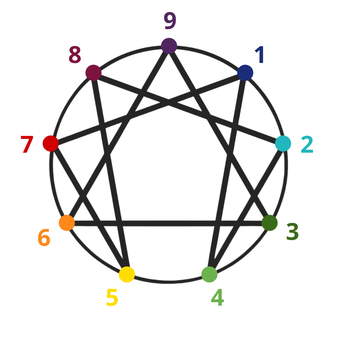|
I’ve done a significant amount of training, seminars, and assessments in the areas of personal, spiritual, relational, and professional growth. From Myers-Briggs to StrengthsFinder to APEST, and many more, there are lots of wonderful tools to equip us for self-awareness and growth. Each of them has its strengths and limitations. But let me tell you that one of the most useful tools I've found for growth and transformation is the Enneagram. There is no way I can do a comprehensive exploration of the Enneagram in one blog post, but I'd like to give you an overview of what it is, a look at the nine personality types and their primary features, and how to explore it for yourself. What is the Enneagram? The Enneagram is a personality typology that helps us identify specific patterns of personality by describing the traits of nine distinct types. The personality types and connecting lines between them form the symbol that is the Enneagram ("ennea" meaning nine and "gram" meaning drawing). Each type within the Enneagram sees the world differently, and interprets why one thinks, feels, and behaves in particular ways. The Three Centers of Intelligence Each of the 9 types is grouped in a triad, according to a common predominant "center of intelligence": body/gut, heart/feeling, or head/thinking. Each of us functions through the three different centers of intelligence, but have one primary center of intelligence that dominates how we perceive, process, and express. Each center's function has its advantages and disadvantages - ways that help us interpret and interact with the world, and ways it can steer us off course. The Instinctual Center (Types 1, 8, and 9) corresponds to our instinctual functions: when thought initiates movement within you. Impulses from the instinct, or gut, center can be a solid guide to right action. The Heart Center (Types 2, 3, and 4) regulates the feeling function: the experiences and expression of emotions. It allows you to feel emotions and connect to others through empathy. The Head Center (Types 5, 6, and 7) regulates the thinking function: the experience and expression of thoughts, beliefs, and other cognitive ability. This is essential to analysis and reasoning. By identifying your triad first, you can eliminate the other six types and focus on which of the three types in your triad is your main type. The Nine Personality Archetypes The nine personality archetypes within the Enneagram have a highly accurate articulation of the automatic patterns associated with each type. Each type has a habitual "focus of attention," prominent patterns of thinking, feeling, and behaving, Each of us will identify with different features from all of the nine types, but there is one dominant type that is our primary one. Below are brief descriptions of the nine types, including their primary characteristics, and core fears and desires. Type 1: Moral Perfectionist Primary Characteristics: Principled, purposeful, self-controlled, perfectionistic. At Their Best: Ethical, reliable, productive, wise, idealistic, orderly, self-disciplined. Focus of Attention: Ones focus on noticing error in the form of deviations from an internally generated ideal, discerning right and wrong, and relying on rules and structure. Core Desire: To have integrity, balance, be virtuous, to be ethical, to be good. Core Fear: Fear of being bad, evil, angry, wrong, corrupt, or irresponsible. Core Weakness: Anger and resentment. Ones repress their anger, and express criticism. Type 2: Supportive Advisor Primary Characteristics: Generous, demonstrative, people-pleasing, possessive. At Their Best: Loving, compassionate, nurturing, generous, supportive, hospitable, tuned into people's feelings. Focus of Attention: Twos focus on relationships, gaining approval, and seducing others through helpfulness as a strategic way to get their needs met. Twos read the people around them and align with others' moods and preferences in order to maximize the potential for positive connection. Core Desire: To feel loved and wanted. Core Fear: Fear of being unloved or unwanted for being purely themselves. Core Weakness: Pride. Twos have an inability or unwillingness to acknowledge their own suffering and needs. Type 3: Successful Achiever Primary Characteristics: Adaptable, excelling, driven, image-conscious. At Their Best: Optimistic, energetic, goal-oriented, industrious, self-affirming, team-builder. Focus of Attention: Threes focus their attention on tasks and goals to create an image of success in the eyes of others. Threes identify with their work, believing they are what they do, and lose touch with their authentic selves. Core Desire: To feel valuable and worthy by being themselves without having to perform. Core Fear: Being worthless, a failure, incapable, unimpressive, unsuccessful, or exposed. Core Weakness: Deceit. Threes deceive themselves into believing they are only the image they present to others. Type 4: Romantic Individualist Primary Characteristics: Expressive, dramatic, creative, self-absorbed. At Their Best: Compassionate, authentic, introspective, supportive. Focus of Attention: Fours focus attention on their own feelings, other people's feelings, and interpersonal connection and disconnection. They feel a lack in their own worth, so they seek romanticized, idealized experiences of qualities they perceive as outside themselves. Core Desire: To find themselves and their unique significance. Core Fear: Fear of being inadequate, emotionally disconnected, plain, ordinary, common, mundane, abandoned, or defective. Core Weakness: Envy. Fours feel that something fundamental is missing in them, and that others possess qualities they lack. Type 5: Investigative Thinker Primary Characteristics: Perceptive, innovative, secretive, cynical. At Their Best: Analytical, wise, objective, curious, sensitive, persevering. Focus of Attention: Fives believe knowledge is power, so they like to observe their surroundings without getting too involved (especially emotionally). They focus on accumulating information, and manage their time and energy by avoiding entanglements with others. Core Desire: To be capable and competent. Core Fear: Fear of being ignorant, overwhelmed, dependent, empty. Core Weakness: Avarice. Fives feel they lack inner resources and that too much interaction will lead to depletion. This leads to Fives isolating and withdrawing. Type 6: Loyal Guardian Primary Characteristics: Responsible, engaging, anxious, suspicious. At Their Best: Loyal, prepared, trustworthy, likeable, compassionate, witty, practical, responsible. Focus of Attention: Sixes focus on thinking about what might go wrong and strategizing and preparing for it. Sixes have an adaptive strategy that centers on detecting threats and coping with fear. Core Desire: To have security and support. Core Fear: Fear of fear itself, danger, uncertainty, chaos, abandonment. Core Weakness: Fear and Anxiety. Sixes live in a constant state of apprehension and worry about possible future events. Type 7: Entertaining Optimist Primary Characteristics: Fun-loving, spontaneous, scattered, charming. At Their Best: Imaginative, confident, productive, enthusiastic, versatile. Focus of Attention: Sevens avoid unpleasant feelings by focusing on what feels pleasant, positive, and pleasurable, especially positive future possibilities. A fear of discomfort fuels quick thinking and creative problem-solving. Core Desire: To be fully satisfied and content. Core Fear: Fear of being incomplete, bored, trapped in emotional pain, limited. Core Weakness: Gluttony. Sevens overcome feelings of inner emptiness by pursuing positive, stimulating ideas and activities. Type 8: Protective Challenger Primary Characteristics: Confrontational, willful, self-confident, decisive. At Their Best: Protective, empowering, loyal, inspiring, resilient, energetic. Focus of Attention: Eights focus on power and control - who has it and who doesn't, and how it's wielded. They are big picture thinkers, and usually don't like dealing with details. They see the world as being divided into "the strong" and "the weak," and they identify with the strong to avoid feeling weak. Core Desire: To protect themselves. Core Fear: Fear of being weak and vulnerable, underestimated, disempowered, humiliated, controlled, manipulated, and unjustly treated. Core Weakness: Lust (for power). Eights have a constant need for intensity, control, and power, and they assert themselves willfully. Type 9: Peaceful Mediator Primary Characteristics: Agreeable, harmonious, reassuring, receptive. At Their Best: Peaceful, generous, patient, accepting, pleasant, empathetic, diplomatic. Focus of Attention: Nines focus their attention on others, their environment, and on avoiding conflict and achieving harmony. Nines typically tuned into the needs and wants of others, but do not not have a clear sense of themselves, and their own motives and desires. Core Desire: To have inner stability and peace of mind. Core Fear: Fear of being loveless, in conflict, overlooked, separate, uncomfortable, discord, alone. Core Weakness: Sloth. Nines are asleep to themselves, their needs, desires, and abilities, and resist bringing their full selves to all of life. How do you figure out your type? It takes time and self-examination to discern our dominant number. Every person is unique, and experiences their personality and the world differently. Each person has characteristics of other numbers. Therefore, figuring out your type is not as simple as taking a quick test and getting the results. The Enneagram is meant to be discerned over time, through self-reflection, prayer, conversations with people who know us, attentiveness, curiosity, and learning. You may initially see yourself in a few numbers. Or you may think you're one type for a while before realizing your actual type is a different one. I encourage you that as long as you keep doing good inner work, ask good questions, and keep learning, you will find your type and reap the valuable benefits the Enneagram offers. I used to endorse online Enneagram tests, but now I do not. Enneagram tests, even the most "accurate" ones, are the least effective way to discern your Enneagram type. There is a sacred journey in the discovery and uncovering of yourself, and I now advocate for different ways of figuring out your number. Here are a few suggestions on ways to figure out your type:
The purpose of the Enneagram is transformation - transformation in your inner self, your relationships, your work, and how you navigate the world around you. If you are ready for transformation, I invite you to dig deeper into the Enneagram, and experience it for yourself. If you want to learn more about the Enneagram, and find ways to use Enneagram wisdom to grow, reach out to me. I integrate it in my work as a spiritual director and formation coach. Have you discovered the Enneagram? How has that journey been for you? You might also enjoy reading: The Top 4 Enneagram Books to Spark Your Spiritual Growth 6 Simple Questions For Self-Reflection How to Use the Wheel of Life Want guidance and inspiration for your spiritual journey delivered to your inbox?
Sign up for my email newsletter Notes From Larissa: Share:
Comments are closed.
|
WELCOMEHi, I'm Larissa. I am an artist and spiritual director on the island of O'ahu in Hawai'i.
SEARCH THE BLOGSUBSCRIBESign up for my email newsletter Notes From Larissa.
TOP POSTSCATEGORIES
All
ARCHIVES
March 2024
|




